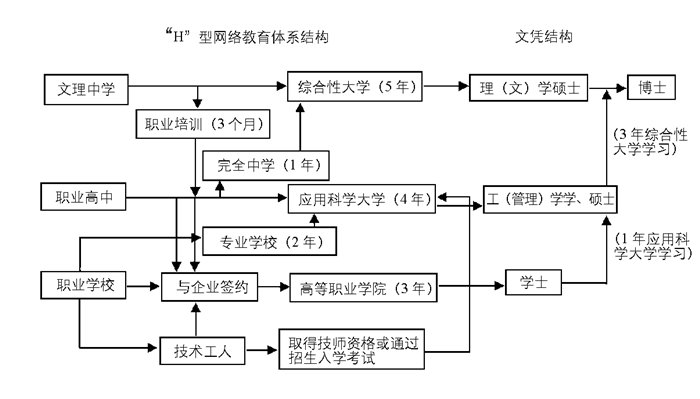-
卓越应用技术型人才是与学术型、工程型人才相对应,将学术科研成果投入到生产实践当中的技能型人才。卓越应用技术型人才拥有高超的动手能力与突出的创造能力,在国家创新体系中处于关键地位。据统计,在工人队伍中,日本技术型人才占40%,德国高达50%,而中国只占5%,截至目前,中国高级技术型人才缺口近1 000万人。[1]卓越应用技术型人才培养越来越受到国家的高度重视。2014年,教育部提出,要引导一批大学向应用技术类大学转型,以建立多层次应用技术型人才结构。本文以我国大学卓越应用技术型人才培养的现实障碍为出发点,以“制造大国”“工业大国”著称的德国大学卓越应用技术型人才培养经验为依据,探寻我国大学卓越应用技术型人才培养的改革方向。
全文HTML
-
当前我国大学卓越应用技术型人才的培养存在着目标失效、教学失真、制度失范等多重问题,致使改革进程缓慢。具体而言,我国大学卓越应用技术型人才培养有三重障碍:
-
大学人才培养的目标之一是为社会服务。然而当前,大学生就业形势日益险峻,而高级技术人才却“供不应求”,这种现象反映出我国大学人才培养目标与社会需求不相适应的矛盾。其背后的深层原因在于:
第一,大学办学的趋利性导致多元化人才培养需求的蒙蔽。在提升排名、争取经费、提高行政级别等“功利性”目的的驱使下,许多医学院、师范学院、职业技术学院等地方单科性院校纷纷合并,向“多学科、综合性大学”发展,由“千校一面”的办学理念走向“千人一面”的培养方式。这看似是大学自我定位不准,实质上是大学争取利益最大化的现实博弈。虽然我国正在不断呼吁不同类型大学改革人才培养目标,丰富应用技术型人才学历结构,然而当前,综合性大学的培养目标仍然基本定位为学术型、工程型人才,缺乏应用技术型人才。综合性大学通识教育的课程理念,知识中心的教学模式,科研能力主导的评价手段都体现了这一目标。社会人力资源呈“金字塔”分布状态,学术型、工程型人才属于“金字塔”顶尖少数部分,而应用技术型人才才是社会建设的主要力量。大学办学的趋利性致使卓越应用技术型人才培养动力消减、产需失调,这一现状亟待改革。
第二,传统价值观影响下“等级制”人才评价标准的形成。受“劳心者治人,劳力者受治于人”观念的掣肘,依据职业类型将社会群体“分层”的扭曲价值观深深扎根于中国社会,这直接导致了学生盲目追求“收入高”、“工作稳定”择业观的形成。重庆市南开中学某高一英语教师在观察自己班上的学生学习状态后在教学笔记中谈到:
“每次在班上看到那些明明对老师所讲的内容感到不知所云毫无兴趣还力所不能及却无奈只能整天坐在教室里无所事事的学生,我都会为他们感到悲哀。如果他们可以把这些发呆的时间利用起来学一些他们感兴趣的有能力达到的,又对今后的生活有帮助的实践技能,那将绝对比现在坐在教室里听天书发呆有用百倍。可惜由于社会对于技术工人的偏见,导致中国应用技术型人才培养质量偏低,也就走进了‘看不起-不愿学-学的差-出路差-发展差-看不起’的恶性循环。”①
① 摘自重庆市南开中学唐一鸣老师教学笔记。
破除社会对技术工人的偏见与“刻板印象”不仅是教育命题,更是社会问题,隐含着我们对不同社会角色与社会地位的主观认知与价值判断。如何改变传统人才观,使每种职业都受到尊重,实现不同类型人才的平等发展,是当下卓越应用技术型人才培养所面临的棘手难题,而对这些问题的回答也是对激发卓越应用技术型人才内生成长动力的有益探索。
-
应用技能的学习需要在实践中完成,布迪厄(Pierre Bourdieu)将这称为“实践的逻辑”,即回归到实践当中,寻找实践的逻辑来指导实践。教学在实践中完成即“做中学”的过程,然而,当下“做”与“学”分离的教学现状成为制约卓越应用技术型人才培养的瓶颈。
首先,课程内容与实践脱节制约了教师的“教”。课程内容与实践脱节主要表现在三个方面:第一,通识课程学分比例重。我国大学基本实行通识教育,以公共必修课和公共选修课为主的通识课程一般占整个课程学分的25%,且多为政治性、基础性知识,与技能学习无关。第二,专业课程理论知识多。据统计,我国应用技术型专业学生所学习的基础理论知识类课程比例高达40%—45%。且课程内容因循守旧,难以与实践结合。[2]第三,实践课程受关注程度低。实践课程主要指顶岗实习、企业实践等操作类课程,所占学分比重低且缺乏规范的考核标准。三类课程内容本身的局限性为教师教学设置“障碍”,使大部分教师在理论与实践相结合的道路上步履维艰。
其次,实践教学中场域缺位限制了学生的“学”。长期以来,校企合作存在“学校热,企业冷”的现状,大学与企业“貌合神离”。一方面,企业缺乏与大学共同培养人才的社会责任感。企业在校企合作中的贡献得不到社会的认可,犹如扮演了“匿名慈善家”。因此,一些企业只招聘技术熟练的工人,而另一些企业只有当急需招聘人才的时候才与大学合作,而不愿建立长期实践基地。另一方面,企业的“经济性”与学校的“社会性”存在先天矛盾。[3]企业在与大学的合作过程中投入大于回报,尝不到校企合作的“甜头”。因此,大学在校企合作中“孤掌难鸣”,真正与大学达成长期合作协议的企业很少,使学生“做中学”难上加难。
-
教育部出台高校转型政策反映出国家对卓越应用技术型人才的培养热情,然而对高校转型现状及问题的冷静审思后发现,制度缺位制约了当下大学卓越应用型人才的培养效率。
第一,高校转型发展亟需配套政策补位。高校转型政策的推出启动了应用型高校体制机制改革的阀门,经费来源、师资队伍重建、教师职称评定、高校评估标准、行业资格认定等一系列问题接踵而至,急需国家出台具体政策加以解决。除实用性政策外,为转型发展“疏通血脉”的道义性、认知性政策也不可或缺,特别是消除高等教育“系统性偏见”及激发高校转型的内生需求的政策,帮助转型高校在高等教育生态中找准位置,以提升转型高校改革效率,实现人才培养目标与手段的对接。
第二,人才培养制度欠缺法律条例规约。目前我国尚未构建完善的法律体系以保障应用技术型人才培养计划、质量监控、评价体系的合法性。这直接将人才培养过程中某些环节置于进退维谷的“尴尬”境地,例如校企合作。由于我国校企合作的法律缺位,校企合作基本呈“自组织”状态,学校与企业双方的责任与义务都很模糊,只要有一方不满意,随时面临项目中止的危机。因此,突破校企合作困局的关键在于以立法为基础实现制度逻辑的“合法性”重构,使应用技术型人才培养从“人治”走向“法治”。
一. 利益诱导与价值偏离致使人才培养目标失效
二. 实践脱节与场域缺位导致应用技能教学失真
三. 政策瓶颈与法规缺失造成人才培养制度失范
-
卓越应用技术型人才培养的难题已经成为阻滞我国建设成为创新型国家的沉疴。相比而言,德国在卓越应用技术型人才培养上取得的成就有目共睹,成为其在二战以后的60年间迅速崛起的“秘密武器”。德国的教育机构种类繁多但分工明确(如图 1)。德国实行双向分流式教育,由普通教育培养学术型、工程型人才,而职业教育培养应用技术型人才,其中,主要由应用科学大学(FH)承担大学层次卓越应用技术型人才培养的职责。
德国大学卓越应用技术型人才培养机制独具特色,在世界享有盛名,其生发于社会文化培育的肥沃土壤,生长于以大学教学策略的有序展开,生成于政策法律保障的制度空间,由三者的相互作用逻辑铸炼而成。
-
德国卓越应用技术型人才培养取得成功的前提是大部分学生愿意选择职业教育。调查表明,75%的德国青年(15岁到25岁)选择职业教育,20%的优等生(成绩A的学生)进入应用科学大学学习。[5]德国对于应用技术型人才的培养热情与他们“人尽其才”的培养目标密不可分,德国的教育总是鼓励学生根据自身特点及兴趣爱好“扬长避短”,找准适合自己的人生坐标。由于教育观、社会观、市场观的三重共生逻辑,激发了大学卓越应用技术型人才的内生成长动力与外在培养动力,使得“人尽其才”培养目标得以最大化满足。
第一,“自主式成长”——以内生需求激发成长动力的教育观。德国教育鼓励学生依靠个人的自由意志来支配生活以实现自己对命运的把握,德国学生对职业生涯的清晰规划则集中体现了这一思想。德国学生在很小的年龄就需对自己的人生道路做出选择,初中毕业后想当工人或者技术人员的选择职业高中或职业学校,想当工程师或者研究员的则进入文理中学学习。事实上,学生确定方向的阶段在五年级到六年级间,这时候学生通常只有10岁或11岁。[6]据报道,德国的学生非常“早熟”。八年级学生就在思考以后读什么大学、是否可再次改变职业方向、是否几年后与女朋友结婚等问题。[7]这种“早熟”其实就是一种“我的人生我做主”的态度。由于学生初次选择学校类型时年龄尚小,难免会出现决策失误,但德国的教育体制非常开放,不同类型的教育相互连通(如图 1),学生可以通过更换自己的学校类型为错误选择“买单”,永远不用担心自己错过教育的“末班车”,这也在另一方面鼓励学生大胆选择自己喜欢的职业。
第二,“等值不同质”——以就业平等促进职业平等的社会观。在德国,职业教育不属于二级教育,而与普通教育有同等价值。《联邦共和国各州高等学校协定》规定应用科学大学与综合性大学的文凭等值,保证了应用技术型人才与其他类型人才的均质性与等值性。在人才市场中,应用科学大学的学生非但没有受到偏见,甚至成为大部分企业的“抢手货”,因为他们比其他学生更具操作能力。德国的这一政策促进了职业平等价值观的生成。正如德国教育家雅思贝尔斯(Karl Theodor Jaspers)提出教育的目的是“启迪自由的天性”,德国人反对“唯文凭论”“教育万能论”等夸大教育功能与价值的思潮,他们坚信人尽其才则为人才,人才的价值始于对社会的贡献。因此,许多职业劳动者对他们的职业具有很高的荣誉感,这甚至可以从他们墓碑上的碑文反映出来。[8]
第三,“订单式培养”——以产业需求推动人才培养的市场观。通常德国的大型企业都有与学校合作的跨企业培训中心,类似于“实训车间”,为企业培养后备技术人才。在这个过程中,企业对培训过程几乎全程监控,负责培训内容及方式的选择、培训场地的提供、培训资金的保障等。换言之,企业在人才培养过程中占据主导地位,所设计的培训内容具有较强的针对性与操作性。通过这种紧密联系,德国学校与企业之间形成了“产学研”一体化的合作模式。这种“产学研”合作模式的基础与前提是“产”,即企业需要什么,学校就培养什么,人才培养目标与地方产业需求高度一致。
-
德国卓越应用技术型人才技能学习的过程中,“做”与“学”不是一种割裂关系,而是在“做中学”的同一关系。这里的“做中学”并不是指将“做”作为“学”的起点,单纯地依靠经验积累来获得知识,而是以“学”为起点,学生对所要操作的技术有一个大概的了解,在此基础上“边做边学”。具体而言,“做中学”的教学方式以下面两种经验为依据。
第一,模块化课程体系的开发。模块化课程即将学习内容整合成不同模块,再分模块进行学习。模块化课程体系的设计取代了传统的注重书本知识和直接经验获取的“知识”本位的课程观,体现了注重个人知识、实践学习的“经验”本位的课程观。模块可进行定性(内容)和定量(学分)二元评价。其中每一学分对应相应的学习总量,包括教师授课学时与自主操作学时,并且两部分学时分配可根据板块内容进行调整。如理论性较强的公共基础模块可采用20:8(教师授课:自主操作);专业基础模块16:12;专业选修模块16:12;实习或培训模块8:20。[9]在课程内容方面,课程设计者通过市场调查,确定专业所需的基本能力并寻找培养这些能力的知识点,整合成培养“能力群”的模块,以此打破互相分离的单科课程,形成以培养能力为主的模块化课程。例如,在机械工程学习中,将原来分别开设的“计算机绘图”“三维软件基础”“工程图学”整合成“机械产品表达”模块,删除其中重复、抽象、脱离实际的内容,增加构型设计表达方面的综合实践项目。[10]总的来说,模块化课程的特点是通过知识点整合、弹性学时的设置形成了符合学生认知特点、灵活多样的知识学习与技能训练的结合方式。
第二,双元制教学模式的推进。双元制教学模式即学校与企业共同参与教学的培养模式。拉加特(Peter Raggatt)认为德国双元制主要有四大特点:学习场所的双元性、经济责任的双元性、法律责任的双元性、学员身份的双元性。[11]学习场所的双元性体现在:企业提供在职培训和兼职场所,而大学负责传授理论及基础知识。学习场所的双元性也保证了学员身份的双元性,他们既是企业的学徒,又是学校的学生。经济责任的双元性是指学校与企业分别资助学生在学校及企业的学习。法律责任的双元性则体现在政府及企业的区别分工。双元制教学模式的特色是“课堂进企业”,以实践教学为主。从学生学习时间分配来看,实践操作占据了大部分时间。以汉诺威应用科学大学为例,其实践教学环节比例占总学时的45%,包括企业实习以及毕业设计。此外,专业课中几乎50%的时间都安排实验、实习或设计制作等。[12]学生在企业实习的时候同时配备教师进行指导,以“师傅带徒弟”的方式进行教学,也称“学徒制”。换言之,学生在“做中学”,而教师在“做中教”。这一方面有利于学生主动承担建构知识的责任,而不是一味的跟随教师的指引,忽视自身的学习主体地位。另一方面,有利于学生更加熟练地掌握操作技能。学生“边做边学”的过程其实是知识不断“内化-转化-内化”的过程,通过循环往复的练习,最终实现个体行为的“习俗化”。
-
德国卓越应用技术型人才培养过程受法律监督。德国从19世纪起就开始对职业教育立法,至今已经形成较为完备的职业教育法律体系(如表所示),为卓越应用技术型人才培养提供系统保障。
第一,以双师型教师队伍建设为基础的人力保障。德国大学卓越应用技术型人才培养的教师队伍分为企业培训师及应用科学大学教师两类。按《职业教育法》规定,教师需达到《培训资格条例》标准并通过行业协会组织的培训师资格考试方能成为企业培训师。《培训资格条例》对不同职业类型企业培训师所需具备的人格素养、专业能力(职业能力与教育教学能力)予以规范。[13]应用科学大学教师的基本条件除学历要求外,还需具备实践工作经验,其中教授至少5年,而其他类型教师通常不少于3年。两类教师皆为知识传授兼职业指导的“双师型”教师,他们是“双能力”“双素质”“双证书”的集合。
第二,以政府企业二元分工为基础的物力保障。法律规定联邦、州政府负责规划和实施培训计划及课程大纲,其中培训计划包括大约378种职业类型。企业的主要职责是在工商联合会注册、组织和评估期末考试,并颁发符合国家认可的职业资格证书。职业资格证书的批准由企业的“社会伙伴”,即雇主协会和工会协商确定。[14]虽然政府严格监管,企业的职业培训仍然高度自治。他们的咨询服务、培训计划的监督以及阶段性的培训评估均由地区工商联合会提供。商会提供全国性的建议,并监督培训过程确保其“职业化”。
第三,以企业税收双重标准为基础的财力保障。法律规定学校教育的经费由政府资助,而在职培训部分则由企业资助。企业资助没有固定的投入标准,但他们同时享受一些国家的优惠税收政策,而那些不参与双元制的企业则不能享受国家优惠税收政策。[15]可以说,德国的职业教育法律非常“务实”,它既明确了学校与企业在人才培养中的权利与义务,又详细规定人才培养的具体准则,为卓越应用技术型人才培养“保驾护航”。
一. 精神场:“人尽其才”目标引导的人才培养动力机制
二. 行为场:“工学结合”教学导向的人才培养运行机制
三. 制度场:“依法执教”制度规范的人才培养保障机制
-
通过对德国大学应用技术人才培养机制的解构,重新审视我国大学卓越应用技术型人才培养的困境,以德国先进经验为突破口探讨我国大学卓越应用技术型人才培养的“再出发”,至少可以从以下三方面进行探索。
-
由上可知,我国大学办学的趋利性与“等级制”人才评价标准导致大学人才培养目标失效,卓越应用技术型人才培养动力不足。据此,我国卓越应用技术型人才培养的当务之急是匡正价值观,寻找育人与用人的切合点,激发大学卓越应用技术型人才的内生成长动力与外在培养动力。
第一,以“三人”教育为基点推动学生择业观转型。“三人”教育即对“人性”“人本”“人才”的重新审思与定位。人性是人最纯粹的精神属性,人性可被高尚的品质所教化也可被利益的驱使所污染。如今我国大学生在择业中盲目追求“收入高”、“工作稳定”,这种功利性的择业取向折射出学生人性中趋利性的“膨胀”,使他们变成精致的“利己主义者”。教育要加强对“真善美”人性的感化与熏陶,关注与尊重人本身的特点与需求,即以“人本”作为教育的逻辑起点,将人的知识、能力、品性作为考量基础加以培养,以实现对人潜能的最大发挥,确立以人为本、人尽其才的新时代人才观。在具体教学情境中,教师要注重引导学生树立正确的价值观,特别是在职业生涯规划教育中灌输“人生本平等,职业无贵贱”的思想,以个人兴趣与特长为导向帮助学生找准自己的人生坐标,发展个性。
第二,以弱化人才界限为基点推动社会价值观转型。对于激发卓越应用技术型人才培养动力这个浩大工程,不能单靠扭转学生功利化择业观,而应从更深入的社会评价机制入手,改变扭曲的“等级制”社会人才评价标准,强化不同类型人才平等发展的理性认识,促进科学合理的社会人才评价机制的形成。重建社会评价机制首先要探寻文凭制度的改革途径,使同等学历不同类型人才文凭等值不同质。其次,提倡高等教育评价的趋异性,以学科排名、专业排名代替大学排名,以科研成果与技术转化双重考核代替单一科研考评,以更好的体现多元化人才评价的内在旨趣。最关键的是逐步取消编制,以弱化不同岗位之间的身份界限,消除应用技术人才在社会中受到的偏见,并消减由“编制”问题导致的大学办学中的趋利性。
第三,以社会需求为基点推动大学人才培养目标转型。如今我国育人与用人失衡的二元矛盾反映出大学培养目标的价值偏离,由此,大学应以社会需求为本实现人才培养目标的价值匡正,这对卓越应用技术型人才培养具有促动作用。借鉴德国经验,大学应在人才选拔、课程设计、教学实施、质量评价等方面加强与企业的沟通与交流,极大地发挥企业在人才培养中的监督作用,使培养目标与企业需求接轨。同时,教师定期去企业进修,了解企业人才聘用标准、生产需求与技术手段并且将这些最新的职业讯息带回到课堂教学中,通过教学内容的不断更新,使教育跟进培养目标。
-
在业务领域“精”而“专”是卓越应用技术型人才的突出特征。因此,在大学卓越应用技术型人才培养过程中,应坚持以“专”为中心,将强化专业性训练作为核心思想及核心原则。在此基础上,建立“学习任务群”课程开发机制与“临床实验型”教研训一体化机制,以实现理论与实践的交互融合,使学生在“做中学”,教师在“做中教”。
第一,建立“学习任务群”课程开发机制。为避免理论与实践“两张皮”的课程设计,需改良原有的“通识课程学分比例重、专业课程理论知识多、实践课程关注程度低”的课程结构,建立“学习任务群”课程体系。“学习任务群”即由模块化、整体性、联系性的学习内容组成的任务群。值得注意的是,区别于德国以学生的能力发展目标为主的“模块化”课程,“学习任务群”课程不单强调能力培养,而是重视学生知识、技术、能力的协调发展。在具体的课程开发中,将学生的课程内容设计为不同的学习任务,每一学习任务由相应主题的“知识群”“技术群”“能力群”组成。以“航空工业数控机床配置”学习任务为例,分别设计有关机械操作原理、零件及规格的“知识群”;数控机床现场观摩、操作为主的“技术群”以及零件加工、自主配置、技术改进等“能力群”。在教师的带领下,以“活动”的形式串联各任务群,通过任务群的各个击破追求多方面、多层次目标发展的综合效应,避免传统教学中知识逐点解析,技能逐项训练的单一线性连接。
第二,建立“临床实验型”教研训一体化机制。我国校企合作的尴尬处境使学生实践场域缺位,制约了学生的学。而德国“双元制”教学模式的核心在于以学习场所的双元性带动学生身份的双元性,实现了教师教学、企业生产、学生学习三大目标的紧密结合。建立“临床实验型”教研训一体化机制即在实践中实现教学、科研、训练三者“并进”,通过教师教学与科研为企业“谋利”从而推动企业发展,使教师、企业、学生三者互利互惠,合作共赢。三者“并进”即在具体实施过程中,以“教研”驱动“教学”,以“教学”驱动“训练”。例如教师在了解工厂生产需求的前提下确立了“超声波在焊缝跟踪中的应用”课题,教师亲自带领学生进入工厂进行焊接作业,并在实践经验的基础上不断改良技术,最终为企业提供生产方案。通过“教研”、“教学”“训练”三者的结合,既有利于提升课题的“信度”,又加强了教学与训练的“效度”。
-
德国职业教育法律为卓越应用型人才培养提供了系统保障。借鉴德国经验,我国可从政策与法律协同作用的视角探寻立体化、操作性强的卓越应用技术型人才培养制度的建立路径。
从宏观上,发挥卓越应用技术型人才培养的政策法律引导作用,以法治精神引领社会价值。加强卓越应用技术型人才培养公共政策的建立,彰显国家对卓越应用技术型人才培养的重视程度,从而引导社会对卓越应用技术型人才培养的“集体无意识”状态走向关注与了解,重塑社会文化心态,为科学合理的社会人才评价标准的形成营造适宜的生长环境。以政策导航确保卓越应用技术型人才培养目标的权威性。
从中观上,完善卓越应用技术型人才培养过程中相关环节的法律制定,以法律条例规范教育行为。首先改革卓越应用技术型人才培养的根本大法——《职业教育法》,明确企业与学校在卓越应用技术型人才培养中承担哪些具体的责任及义务。其次,建立管、办、评分离制度,扩大学校办学自主权,并明晰政府与学校在办学中的权力界限,避免在政府放权、学校用权的过程中出现责任“盲区”[16]。同时完善关于职业资格证书、企业招聘、劳动者权益相关法律,确立卓越应用技术型人才培养各环节的法律保障,保证卓越应用技术型人才培养过程的有序性。
从微观上,制定配套的卓越应用技术型人才培养实施细则,以行动计划预见培养结果。实施细则包括对应用科学大学人才的选拔程序、专业设置、大学培养目标、培养方式、培养内容的确定、校企双方经费分担、师资与场所的提供、学校教育质量评价标准、奖惩机制等内容,以细化应用科学大学人才培养的相关强制规范,保证卓越应用技术型人才培养实施方案与目标的一致性。




 下载:
下载: